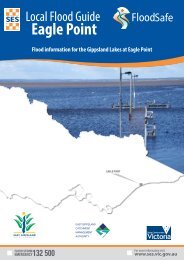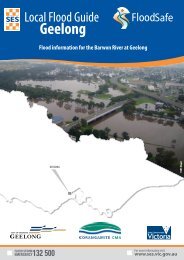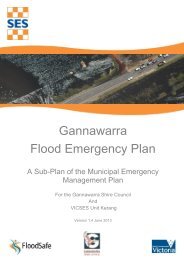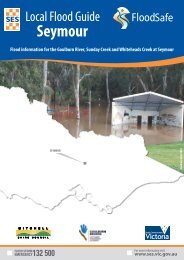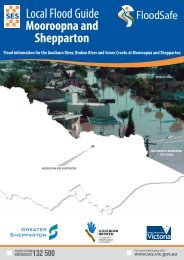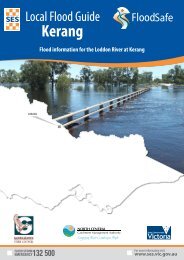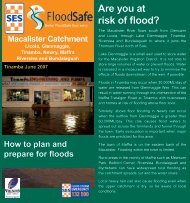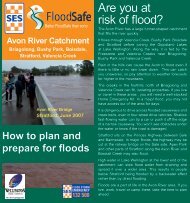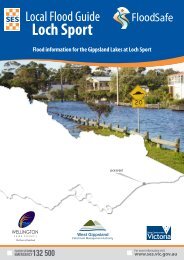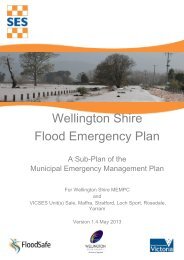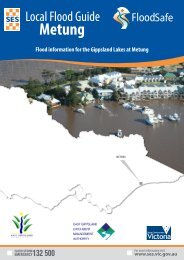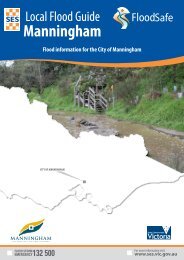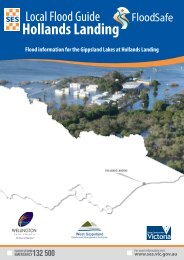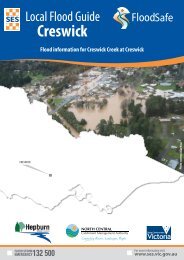Years 7-8 Lesson Plan.pdf - Victoria State Emergency Service
Years 7-8 Lesson Plan.pdf - Victoria State Emergency Service
Years 7-8 Lesson Plan.pdf - Victoria State Emergency Service
- No tags were found...
You also want an ePaper? Increase the reach of your titles
YUMPU automatically turns print PDFs into web optimized ePapers that Google loves.
Teacher <strong>Lesson</strong> <strong>Plan</strong><strong>Years</strong> 7–8FloodSafeOverview<strong>Victoria</strong> <strong>State</strong> <strong>Emergency</strong> <strong>Service</strong> (SES) has developed an educational investigative game(www.vicses.com.au/floodsafe-game) which encourages the identification and learning about hazardousobjects which can be found in floodwater and cause harm.This lesson plan can be conducted before or after the game has been played and assists in consolidatingstudents’ learning and understanding.It is suggested that any observations, student work or comments recorded during this lesson be displayed inyour classroom, under the heading ‘Hidden dangers in floodwater’, for others to see and learn from.Outline Materials Time ConclusionTo use computersto identify floodaffected areasin <strong>Victoria</strong> andreinforce thedangers ofswimming, walkingand playing infloodwater.• Pencils/textas• Writing paper• Support material #1: Floodexamples• Support material #2: Types offloods• Support material #3: Fact sheet oninjuries and diseases• Access to computers and thewebsite www.vicwaterdata.net• Support material #4:www.vicwaterdata instructions• Worksheet #1:www.vicwaterdata investigation• Support material #5: FloodSafeawareness posterApprox60minutesStudents will use computersto identify flood affectedareas of <strong>Victoria</strong>, andparticipate in discussionsabout safety in floodwater.Introduction:10 minutes1 Show students Support material #1 of flood affected areas. Ask the students if they know what hashappened in these pictures. Discuss flooding with the students. What is flooding? How does floodinghappen? Where does it happen? Student’s responses can be recorded on cards or a large sheet of paperand displayed.2 Discuss the following different types of flooding (see Support material #2 for further information):• Riverine flooding – when rivers burst their banks and the water covers any surrounding low lyingground.• Flash flooding – usually along creeks and drains which have a small catchment area. The water rises veryrapidly in a very short time. (Sometimes within only minutes!)1/2
• Storm Surge – severe low pressure systems over the sea can cause very large waves and higher oceanlevels. These can cause flooding of low lying land along the coastline including estuaries, bays andlagoons.• Dams – dam walls can fail and cause bad flooding downstream. The water can be very fast moving andcontain a lot of debris.3 Using images from Support material #2 ask students to try to identify which type of flooding has occurredin the different pictures. Ask the students to think about what type of flooding could occur near them.Activity4 Read out the following information:30 minutes<strong>Victoria</strong> has a long history of flooding and is home to many flood-prone communities. Floods cost<strong>Victoria</strong>ns an average of $465 million every year, and can cause significant damage to homes, businessesand community infrastructure.An estimated 150,000 homes and businesses in <strong>Victoria</strong> have a one per cent chance of flooding eachyear, it is very important that all <strong>Victoria</strong>ns are prepared for the possibility of flooding.Source: http://www.ses.vic.gov.au/prepare/floodsafe5 Discuss the effects flooding has on people, including the injuries and fatalities that sometimes may occurduring floods (see Support material #3 for further information).6 On computers, ask students to visit www.vicwaterdata.net to locate where they live and discover if theylive in a flood affected area. (For additional assistance using this website, see Support material #4.)7 Distribute copies of Worksheet #1 and ask students to locate their suburb/address to see if they live inflood affected areas or try to find areas in <strong>Victoria</strong> that will be affected by flood. Students can also look upfamily or friends who live in other areas of <strong>Victoria</strong> and explore the type of flooding that occurs, how often,etc.Extension activityAs an extension, students can explore Wetlands, what they are, are there any located in their suburb or close bysuburbs, or those of family and friends, and if so, what Flora and Fauna inhabit the area.Conclusion8 Students share their findings with the class.15–20 minutes9 Display Support material #5, look at the main message at the bottom of the poster; ‘Never swim, walk orplay in floodwater. You don’t know what you are getting into’. Discuss the content of the poster, what iscontained in the floodwater and what it could do to you, and what they think the second sentence in themessage means.10 In conclusion, ask everyone to share one thing they have learnt about floodwater and why they should notswim, walk or play in it.Safe<strong>Victoria</strong>n <strong>State</strong> <strong>Emergency</strong> <strong>Service</strong>168 Sturt Street,Southbank, <strong>Victoria</strong> 3006Telephone: (03) 9684 6666Fax: (03) 9684 6659Website: ses.vic.gov.au2/2
FloodSafe Support Material #1Flood examplesSource: http://commons.wikimedia.org/wiki/File:Driving_through_flash_flood.jpgSource: http://www.abc.net.au/news/image/1907294-3x2-340x227.jpgFlash flooding
FloodSafe Support Material #1Flood examplesSource: http://web.mst.edu/~rogersda/teton_dam/Dam failureSource: http://www.acus.org/content/hurricane-sandy-storm-surgeStorm surge
FloodSafe Support Material #2Types of floodsSource: http://www.barraba.com.au/manilla-river-rises-in-barraba-73.cfmRiverine floodingIn riverine flooding, relatively high water levels overtop the natural orartificial banks of a stream or river. The nature of riverine flooding canvary significantly in terms of cause, timing and depth between differentlocations. Coastal rivers with short, steep headwaters often have floodsthat rise and recede quickly. Inland floods with low gradients have floodsthat move slowly down the river, sometimes lasting for several months.
FloodSafe Support Material #2Types of floodsSource: http://commons.wikimedia.org/wiki/File:Driving_through_flash_flood.jpgFlash floodingFlash flooding occurs when soil absorption, runoff or drainage cannotadequately disperse intense rainfall, and is usually caused by slowmoving thunderstorms. Flash floods are generally defined as developingin six hours or less from rainfall to the onset of flooding.
FloodSafe Support Material #2Types of floodsSource: http://web.mst.edu/~rogersda/teton_dam/Dam failureAlthough dam failures are rare, their effects can be significant. In <strong>Victoria</strong>dam safety is monitored, and warning arrangements are in place towarn downstream residents of potential dam failure threats. Should damfailure occur, significant downstream flooding can involve potentiallyswift flowing water and high amounts of debris.
FloodSafe Support Material #2Types of floodsSource: http://www.acus.org/content/hurricane-sandy-storm-surgeStorm surgeStorm surge occurs when sea levels are elevated above the usual tidallimit due to the action of intense low pressure systems over the openocean. The low pressure causes sea level to rise as there is less airpressing down on the sea. Combined with gale force onshore winds,this can lead to flooding of low-lying coastal land.
FloodSafe Support Material #3Injuries and diseasesInjuryInfectious DiseasesCause: Ingestion orexposure to floodwaterDiarrheal DiseasesCause: Ingestion orexposure to floodwaterWound InfectionsCause: Sharp objectshidden in contaminatedfloodwaterDisease• E. Coli – Can cause diarrhoea, while others cause urinary tractinfections, respiratory illness and pneumonia.• Hepatitis – Can cause malaise, muscle and joint aches, fever, nauseaor vomiting, diarrhoea, and headache.• Typhoid – Fever, headache, general discomfort, diarrhoea.• Eating or drinking anything contaminated by floodwater can causediarrheal disease.• Wash hands.• Do not play in floodwater.• Open wounds and rashes exposed to floodwater can becomeinfected.• Cover open wounds with a waterproof bandage.• Keep open wounds as clean as possible by washing.Chemical HazardsCause: Contamination offloodwater by chemicals• Be aware of potential chemical hazards during floods. Floodwatermay have moved hazardous chemical containers of solvents orother industrial chemicals from their normal storage places.DrowningCause: Entrapment inwater or vehicles. Unableto swimAnimal and Insect BitesCause: Floodwatercontains live snakesand insects• Floodwater poses drowning risks for everyone, regardless of theirability to swim. Swiftly moving shallow water can be deadly, andeven shallow standing water can be dangerous for small children.• Vehicles do not provide adequate protection from floodwater.They can be swept away or may stall in moving water.• Floodwater can displace animals, insects, and reptiles. To protectyourself and your family, be alert and avoid contact.Electrical HazardsCause: Water becomeselectrified.• Avoid downed power lines.• Electrocution from unprotected wires or wet electrical equipment.WoundsCause: Sharp objectshidden in floodwater• Floodwater may contain sharp objects, such as glass or metalfragments, that can cause injury and lead to infection.
FloodSafe Support Material #4www.vicwaterdata.net1. Visit www.vicwaterdata.net.2. Select ‘Map for Site Selection’.3. Looking at the Map of <strong>Victoria</strong>, please locatewhere you live. This can either be done byclicking onto a specific area or holding the mousedown and creating a box around an area. Themap will automatically zoom into the selectedarea. (You may need to repeat these steps on anumber of occasions to get as close to a specificspot as required.)4. Once zoomed in, to the right-hand side, underthe main heading ‘Map layers’, select the folderSurface Water, then tick the box ‘1 in 100 yr flood’and select ‘Refresh Map’. (If the program doesn’tallow you to tick the box, this means that youhaven’t zoomed in close enough.)• 1 in 100 yr flood event is probability of aflood of a given size or larger occurring inany one year.• The blue overlays which will be seen if in aflood affected area, demonstrates what itwould look like theoretically if a flood wasto occur in that particular area.• This data is based on information collectedby Local Catchment Authorities in <strong>Victoria</strong>who have undertaken flood studies, whichthey then use to flood model various areas.5. The map will then display, if you live in an areathat might be flooded (or not), and the area thata flood could potentially cover.6. Extension: Explore the data relating to Wetlands,which is also located under the heading ‘SurfaceWater’. This will provide information regardingWetlands in different areas. You could alsoinvestigate what Flora and Fauna live ineach Wetland.
FloodSafe Worksheet #1www.vicwaterdata.net1. Visit www.vicwaterdata.net and explore the 1 in 100 yr flood data.2. Complete the below table with your explorations of 1 in 100 yr flood data.Area searched(either address orsuburb)Located in a flood affected area(If yes, could explore the type of flooding, howoften it occurs, etc)12341/2
FloodSafe Worksheet #1www.vicwaterdata.net1. Visit www.vicwaterdata.net and explore the Wetlands data.2. Complete the below table with your explorations of Wetlands data.Area searched(either address orsuburb)Located in a Wetlands area(If yes, could explore the Flora and Fauna.)12342/2
FloodSafe Support Material #5FloodSafe awarenessposter
FloodSafe Support Material #5FloodSafe awarenessposter



